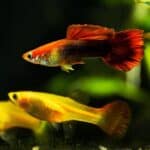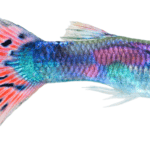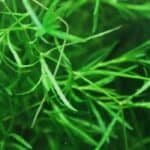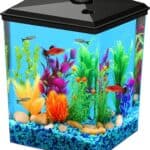Once you’ve got all of the equipment you need to begin breeding guppies, the fun begins!
Choosing your first adult guppies that will be the beginning of your line is a process that can take some time. A vital part of breeding guppies is selecting good quality founding fish, in order to ensure that your eventual guppy lines are healthy, appealing to look at, and possess a range of desirable traits.
It is normal to start with three guppies as your breeding adults: two females and one male.
In this article, we will guide you through the process of breeding guppies, from selecting your adults to raising the fry.
Step One: Choosing your founding adult guppies
While you can just pop along to a pet store or aquarium retailer that sells guppies and select attractive-looking fish, if you intend to take breeding guppies seriously, you might want to consider buying your founding stock from a professional breeder or show breeder, as they will often be able to offer a better range of options.
Look for fish that are mature and healthy, and that display the traits that you wish to produce or enhance.
Select for shape, color, pattern, and traits that you find physically appealing, but don’t forget to make sure that the fish that you pick has good conformation and do not have any curvature of the spine or flattening of the heads, which can indicate poor quality stock.
While female guppies will never be as bright or striking to look at as males, do try to pick females that are the most physically appealing of those on offer, as the quality of the female fish will affect the subsequent males too! When you spot the fish that you like the look of and want to own, you will normally know it straight away!
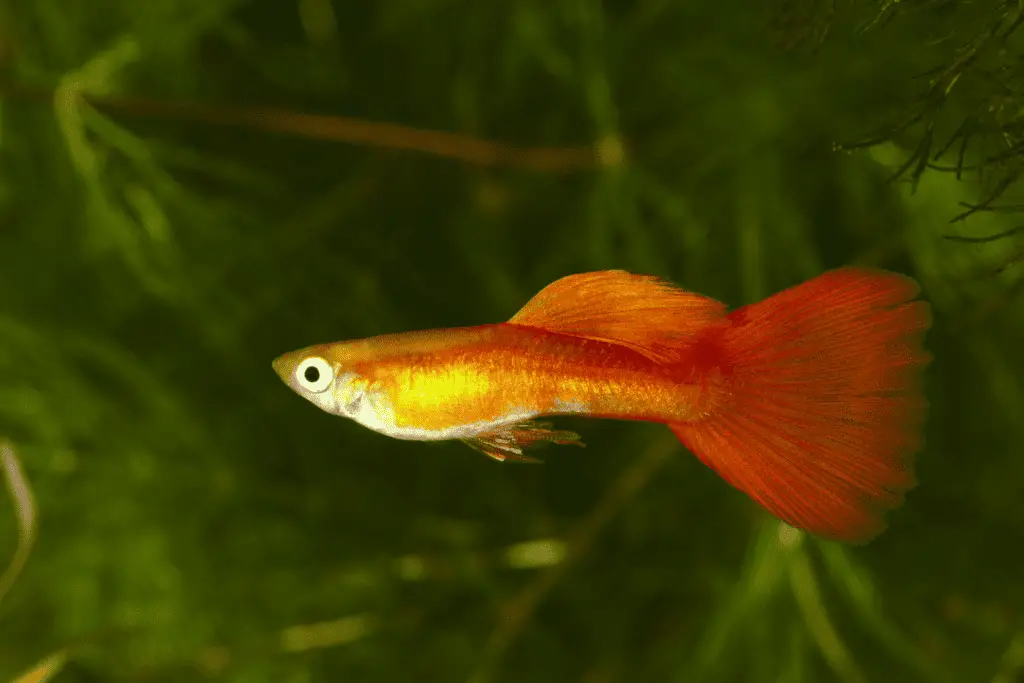
Step Two: Breeding guppies in the main tank
Place your two females and one male into the large tank where the adult fish will reside, and let them get on with things!
Guppies generally breed quickly and prolifically, although they may need some time to settle down in a new tank. It is not unusual for healthy breeding-age guppies to breed within 24 hours of introduction!
When the females and males are together, provide highly nutritious food to encourage breeding, and keep the tank temperature at around 25-26 degrees Celsius.
Step Three: Recognizing conception in guppies
It is easy to spot when a female guppy has conceived, as she has an area on the abdomen just above the fin that is known as the “gravid spot.” This is where her eggs are situated, and after fertilization, this area becomes noticeably darker.
Step Four: And wait…
The period of gestation of the guppy is between 26 and 31 days, with the average being 28 days from fertilization.
During this time, the stomach will grow larger and darker, and take on a boxy rather than round appearance. If your female guppies keep still for long enough and you can look closely, you may even be able to spot the fry within the abdomen!
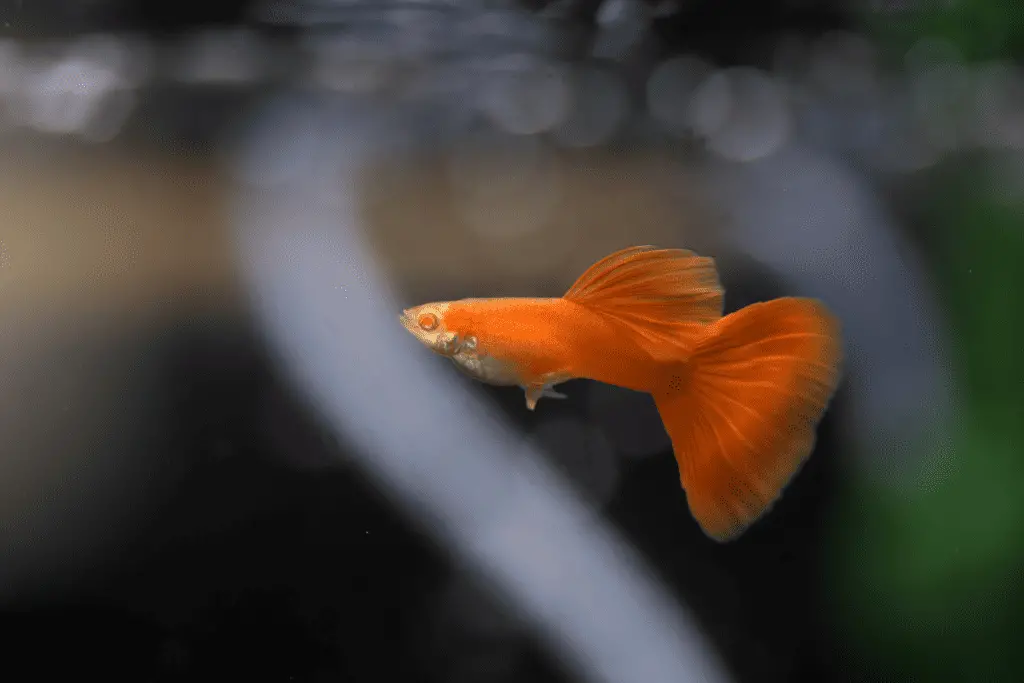
Step Five: Moving your female guppies to a breeding tank
Once the time of delivery comes nearer, you will need to move each of your females into their own breeding tank, so that you will be able to identify which fry are produced by which female.
Step Six: Labor
If you intend to use a breeding trap or partition off the tank for delivery, put this into place as the time to give birth grows nearer.
You can usually judge when the time is at hand, as the female guppy will become much less active and tend to hide, and you may even observe the contractions, which appear like a shivering movement through the body.
She may also like to stay around the tank heater and stop eating in the hours immediately leading up to the birth.
Step Seven: Care for your new guppy fry!
The time it takes to deliver the fry can vary, as will the amount of fry produced. Anything from 5 to 50 live young is normal, although not all of these will necessarily make it to maturity.
After the fry have been born, it is important to care for them properly and give them every chance to survive, by providing plenty of foliage and cover in the tank to keep the female guppy from eating them. You can also protect the fry by placing the female guppy back into your main tank after the birth, although she may become pregnant again in short order.
You can also partition off your breeding tank to keep the fry safe until they grow too large to be eaten by the other fish, or make provision for plenty of plants and hiding places for the fry.

Guppy Breeding Equipment
If you are considering making your first foray into the interesting and very rewarding world of breeding guppies, it is entirely possible to simply stock your tank with male and female guppies and let them do what comes naturally!
Breeding guppies is not difficult, and they will generally reproduce without intervention under most circumstances, even when you would prefer that they didn’t!
However, if you want to raise bright, colorful guppies that are healthy, physically appealing, and possess a range of desirable traits, it is wise to give the procedure a little more consideration.
If you’re thinking of breeding guppies professionally, or want to produce an appealing and desirable line, then having the right equipment and a structured plan of how to go about things is essential.
In this article, we will introduce you to the basic equipment you will need to start selectively breeding guppies.
The main guppy tank
First of all, you will need a main base tank in which your adult guppies will reside. This tank should be relatively large, with plenty of room for the amount of fish you plan to house within it, and should not be overcrowded.
If you are selectively breeding guppies from scratch, you will usually begin each strain with three fish: Two female and one male. In order to keep a tally of which fish breed and what line the offspring come from, you will need a different tank for each set of three fish.
The breeding tanks
For each hatching of fry, you will need to provide a second tank to house them. This means that if you have two female guppies and plan to breed them both, you will need two breeding tanks.
These tanks can be relatively small, as they are only intended to house fry as they grow and before they become large enough to be housed with other adult fish.
A breeding trap
A breeding trap is a small plastic container that can be hung or fixed into the breeding tank. It has a removable slatted partition in the center.
When your female guppy is ready to birth the fry, place her in the breeding trap and insert the partition. When the female fish drops the fry, they can then swim through the slats in the partition into the safety of the other half of the trap, to keep the female guppy from eating them!
The female guppy can then be removed from the breeding tank and placed back in the main tank.
A breeding trap is optional, and it is entirely possible to breed guppies without using one, although they do come in handy!
Lighting
Normal aquarium lighting will be required for breeding guppies; this is just the same standard tropical fish lighting you would use for non-breeding tanks.
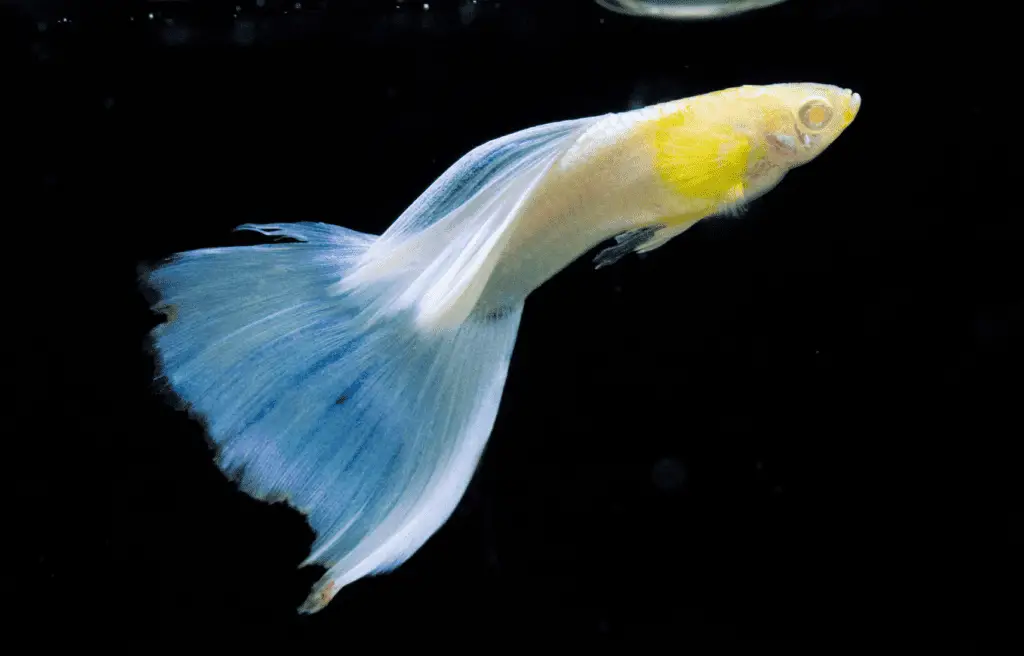
Heating
Heating all of the tanks properly is important, and as you will on occasion have cause to move fish from one tank to another, it is also necessary to match the temperature of the tanks.
Filtration
Guppies aren’t as messy as goldfish, but they do produce a reasonable amount of waste and fry are particularly sensitive to this. It’s therefore important to consider adequate filtration within the tanks, particularly when breeding guppies.
Small, light fry can, however, be sucked up into the filter workings, so you must protect the end of the filter inlet with something that will prevent fry from being pulled in!
A piece of gauze, the end of a pair of pantyhose, or using a sponge filter is useful for this.
Nets
A selection of nets to move your fish will be useful; particularly keep a lookout for a net with a very small, fine mesh that can be used to pick up fry once is has reached a reasonable size.
An air pump
Good aeration and movement of the water are vital in all fish tanks. You should ensure that even your smallest fry tanks include an air pump that creates a gentle flow in the water.
Plants
Plants provide an essential source of nutrition for fish and give small fry a place to hide from the larger fish.
Some good plants for guppy tanks include java fern, Anubias barteri, hornwort, and water sprite.
How to care for baby guppies
Guppy fry care is a key stage in breeding guppies.
Guppy fry are not reliant upon their mothers for any of their needs, and adult guppies may even eat their young, so it is important to keep the fry protected from larger fish.
Keeping your fry in a tank of their own until they are large enough to be mixed in with your general fish population is recommended. At the very least, you should partition off the tank so that fry can keep out of the way of the mother fish!
In this article, we explain proper guppy fry care so that you know how to look after your fry until they are large enough to be housed with adult fish.
Water quality
Newly hatched fry are more sensitive to fluctuations in water quality than larger fish. Keeping a careful eye on water quality is therefore extremely important and you should test the water regularly.
Test for ammonia, nitrite, and nitrate levels. Keep ammonia and nitrite at zero ppm, and nitrate at under 10 ppm.
You also need to perform regular partial water changes. But be careful! Make sure that you don’t dispose of any guppy fry along with the water! Use a siphon with gauze over the end to suck up tank water, so that fry do not get sucked into the siphon.
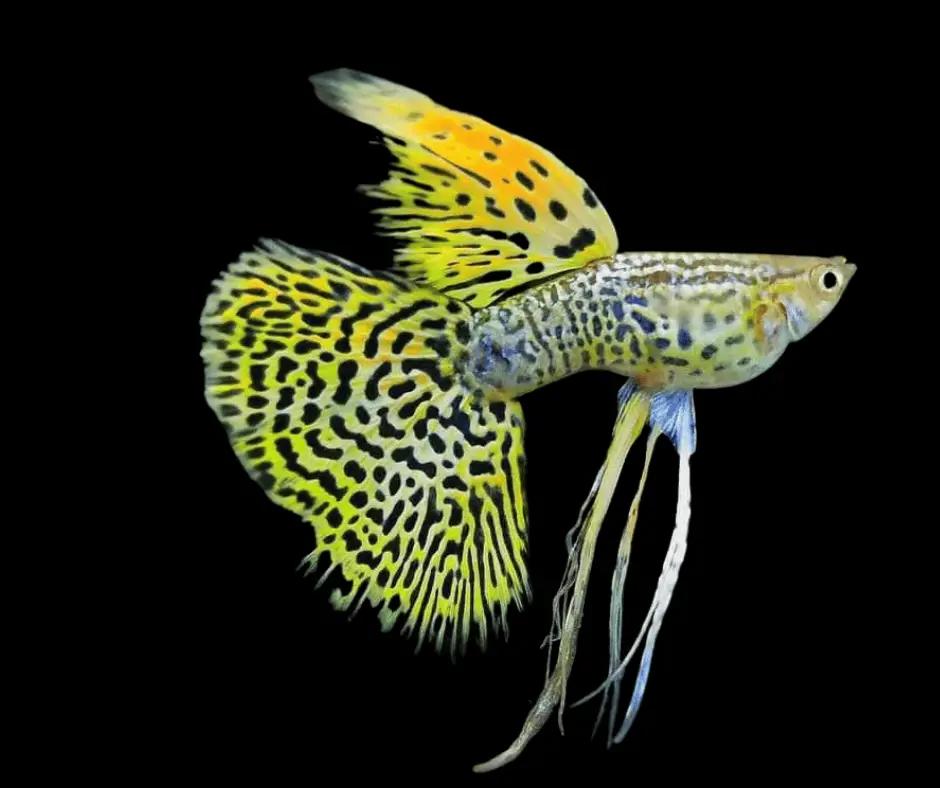
Temperature
A stable water temperature is vital for the well-being of your fry. The temperature should be uniform throughout the tank. Keep a thermometer in the tank to monitor this, and aim for a temperature of 24-26.5 degrees Celsius at all times.
Feeding guppy fry
Guppy fry are too small to get their mouths around pellets, large flakes, or other adult fish food, and so their feeding requires a little extra consideration. You can either feed a dedicated fry food or crush up larger fish food flakes.
You may also wish to supplement their diets with live or frozen foods such as brine shrimp or bloodworms. Variety is important when feeding fry, to ensure that they receive all of the nutrients that they will need, so offer a range of different options to your fry as they grow.
Fry need to eat regularly, and feeding as often as eight times a day may be required to allow your fry to thrive. Remove any uneaten food from the tank promptly and take care not to overfeed, as discarded food rotting in the water can play havoc with your water quality.
Remember that as your fry grow larger, you will be able to feed them larger pieces of food!
Checking for problems
Fry have very delicate immune systems, and are unlikely to survive any injuries or illnesses. For this reason, it is important to keep a careful eye on the health of your tank and the fry within it and tackle any problems promptly.
Fry will also not generally survive dosing of the tank with any of the usual treatments used to tackle the disease in older fish, and so the only way to prevent a sick or diseased fish from infecting the whole fry population is by removing them from the tank as soon as you spot a problem.
Monitoring the growth of your baby guppies
Keep an eye on the rate at which your fry are growing, and ensure that they are receiving enough food to support their needs.
All of your fry from the same hatching should grow at roughly the same rate, and if any of the fish are significantly smaller than the rest of the batch, examine them carefully to ensure that they are not sick or deformed.
Once your fry have reached 6-8 weeks old, they will generally be large enough to survive in your main tank without being eaten. At this point – when the smallest fry is bigger than an adult guppy’s mouth! – you can place your lovingly-bred juvenile fry into the main tank with your other fish.
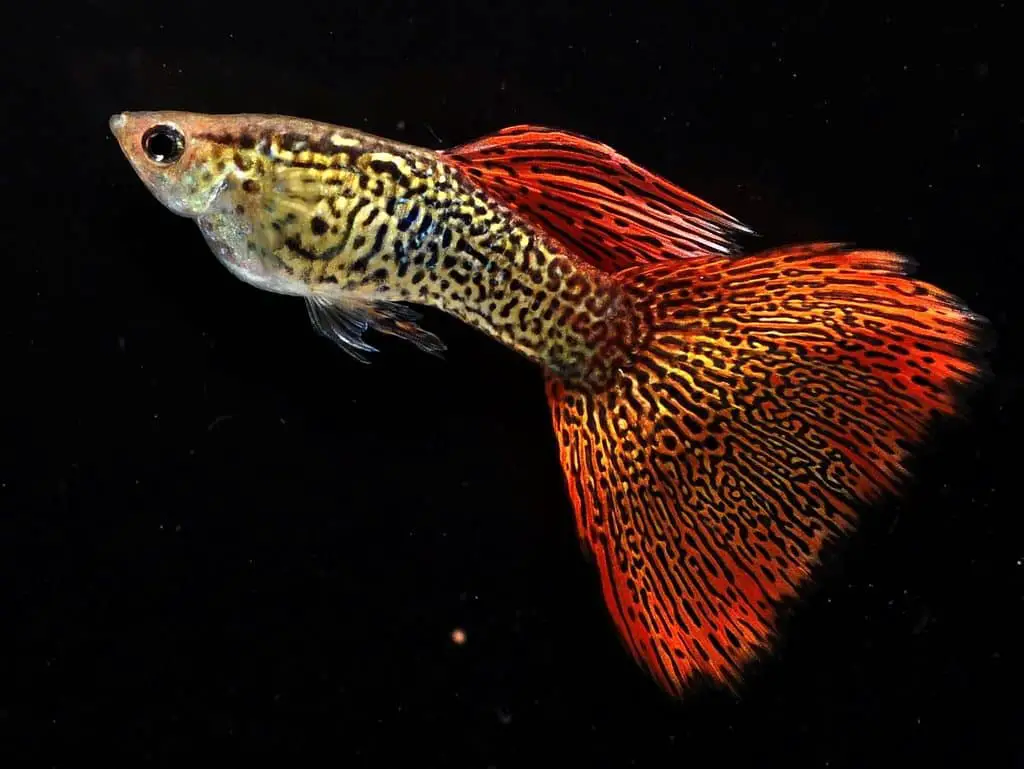
Selectively breeding guppies
Selective breeding means deliberately breeding guppies with certain traits (such as a particular color or tail shape), and phasing out undesirable characteristics. In order to achieve this, you need to do a reasonable amount of forward planning, ongoing monitoring, and record-keeping!
First of all, decide upon the traits that you wish to achieve in your guppies, be they pattern, tail shape, or color. Begin your guppy lines with good quality parent fish, which display good quality examples of these characteristics.
Colors and shapes
When you begin breeding guppies, it is a good idea to decide upon the specific characteristics that you would ultimately like your breeding lines to possess, and tailor your breeding programs to achieve them.
There are various different factors to take into consideration here, including the shape of the tail and fins, the coloration of the fish, and the patterns that your guppies display.
When you begin breeding guppy with your very first fish, it is a good idea to aim for just one or two specific traits, and as time goes by and your lines become more established and reliably produce good examples of those traits, move on to more complex combinations of details.
In this article, we will provide a basic run-down of the different strains of guppy that you can choose between and selectively breed to achieve.
Guppy tail shape
There are a great many different tail shapes and size variants in the guppy, and the tail is one of their most defining features.
Selecting a desirable tail shape and sourcing guppies that possess it will ensure that your fry – and subsequent lines of guppies – will stand an excellent chance of displaying that trait. There are twelve main recognized guppy tail shapes:
- Fantail
- Triangle tail
- Veil tail
- Flag tail
- Double swordtail
- Top swordtail
- Bottom swordtail
- Lyre tail
- Pintail
- Spade tail
- Spear tail
- Round tail
Guppy coloration
Male guppies are generally much more colorful than females, so picking a male with a good, strong color and appealing appearance is important, but do not overlook your females either!
Remember that the genes present in the female will affect the coloration of the subsequent fry, both male and female, so ensure that both sides of the parentage are good examples of the color variety you hope to achieve.
As coloration is genetically determined, it is also important to take into account the dominant or recessive traits of coloration.
Dominant genes are much more likely to show traits in the offspring than recessive ones. With recessive genes, usually, both parent fish must possess the gene in order to provide a reasonable chance of the offspring sharing that trait.
Here is a run-down of some of the basic guppy colors and the genetic traits that enable them:
- Gray: Dominant
- Bronze: Recessive
- Blonde: Recessive
- Albino: Recessive
- Lutino (a yellow gene mutation): Recessive
- White: Recessive
- Silver: Recessive
Reds and blues are commonly seen in guppy color schemes, but there is not any one definitive answer as to whether they are dominant or recessive!
This is because there are several different gene combinations that are responsible for producing blue or red colors. The color will depend on which of these combinations are in play- something that you can only find out through trial and error!
The same applies to related colors that contain elements of red or blue, such as green, orange, purple, or pink.

Patterns and markings in guppies
There are seven main pattern styles in the guppy, and most other pattern variations come about as a result of selective breeding to produce a new variant.
- Snakeskin guppies have a pattern like a chain mail across around 85% of their bodies and fins.
- Lace guppies have a pattern similar to snakeskin, but this is rather fainter and less pronounced.
- Grass guppies have delicate black dots on their dorsal and caudal fins.
- Leopard guppies have rosette spots across their tail, body, or both.
- Mosaic guppies have a tail pattern that forms a random and irregular arrangement of spots or mesh.
- Moscow guppies are particularly interesting to breed, as their color and pattern intensity change depending on how they feel! The Moscow guppy is sometimes known as the “chameleon guppy” for this reason.
- Tuxedo guppies have a graduated body color going from light on the head and chest to dark on the main part of the body.
There are thousands of different guppy color, pattern, and tail shape combinations and many more selectively bred mutations and fusions of different types.
It would be impossible to list all of them without writing a book of several hundred pages long, but hopefully, this introduction has provided a good base to get you started!
Line breeding
Line breeding is the term used to refer to the process of mating related guppies together to reliably produce or enhance the desirable traits of the fish.
Subsequent generations of the best examples of the offspring are then mated with other related fish in the line that also possesses the desirable traits, to ultimately produce a specialist line that reliably produces fish that display the most prominent and desirable features you are aiming to achieve.
It is entirely possible and often recommended to mate female offspring with the father of the line to achieve good results, yet breeding male offspring with the mother of the line generally fails to produce positive results, and so this is best avoided.
Outcrossing
Outcrossing refers to breeding a guppy of one line with an unrelated guppy, to provide the additional genetic diversity necessary to support health and good conformation, and reduce the chances of producing fish with faults or deformities, such as curvature of the spine.
Breeding closely related guppies and their subsequent generations over and over again can serve to introduce a range of undesirable factors as well as desirable ones into the line, due to the limited amount of diversity present within the gene pool.
Outcrossing is an important part of line breeding, and outcrossing your related breeding guppies every few generations will help to maintain the genetic robustness of the line without sacrificing the desirable traits of the strain.
Outcrossing can also be used to introduce a new desirable trait into your line, such as a particularly vibrant color or a new tail shape.
Backcrossing
Backcrossing refers to mating a guppy from a line back to one if its earlier ancestors, to restore the progression of the line’s traits to a previous state and remove or phase out an undesirable trait that has crept in somewhere along the way.
Often, one deliberate backcrossing is sufficient to correct an undesirable issue, although you may have to undertake the process more than once to achieve success.
Culling guppies
Culling is an important part of selectively breeding guppies, as it removes fish with undesirable or indistinctive traits from the potential gene pool.
Guppies that are deformed, sickly, or physically sub-par should be put to sleep, but guppies that are healthy and viable but simply not in line with what you wish to achieve from your line can be sold or given away to other hobbyists or the retail fish trade for pet shops.
Keeping records when selectively breeding guppies
In order to keep track of what is going on with your guppy breeding program, which fish is which and what your matings have achieved, keeping accurate and conscientious records is vital.
If you are not sure what you need to record and how to interpret the information, recording the following details should provide you with everything that you need:
- Starting with your parent stock, assign each founding guppy pair or trio a number so that you can trace and identify the origins of your subsequent fish from each mating.
- Notate the sex of each guppy, and the color, pattern, and tail style to establish the type of strain you produce.
- Assign a generational figure to each set of offspring: For example “F” for the founders, and “F1,” “F2” etc for the generation and level of removal from the founders of each subsequent set of offspring.
- Note any crosses and the relations of each fish to each other; for instance, brother to sister, daughter to father, half-sibling to half-sibling, in order to keep track of the relationship of different fish in your line. This will allow you to identify the relationship of different fish to each other and what desirable or undesirable traits breeding them produces, and if backcrossing or outcrossing will be required.
- Keep details of the dates that you breed any fish, which fish were mated, and what date the mother delivers the guppy fry.
- Mark up each of your tanks with what fish are within them, and any pertinent dates in order to keep track of which fish are where, as similar-looking guppies can be hard to tell apart based solely on your written records!

